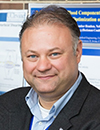|
Held in conjunction with Lab-on-a-Chip & Microfluidics World Congress 2017
03 Oct 2017, at 19:30-22:00 in Coronado Island, California
Inertial phenomena in microfluidic systems are of growing interest due to their ability to manipulate bioparticles. Recent studies demonstrated these effects in microchannels of various geometries, including straight, spiral, and serpentine channels. This workshop aims to expose the inertial microfluidic phenomena for applications in bioparticle separation, enrichment, and ordering. Attendees will gain working knowledge of the fundamentals governing the inertial microfluidics, the approaches used to study these phenomena, and new ways they can be exploited. The workshop is aimed at students, post-docs, faculty, as well as R&D scientists and engineers with interest in inertial microfluidic phenomena and their biomedical applications. All attendees of this training course will receive the presentation files and associated publications and reviews (via online access) enabling a complete and thorough learning experience. This training course includes a light dinner facilitating networking amongst the delegates and foster discussions Specific Topics Addressed in this Training Course Physics of Inertial Migration and Focusing
- Lift forces & focusing in rectangular channels
- Effects of flow, channel size, and bead/cell diameter
- Non-spherical and deformable beads/cells
Methods for Characterization of Inertial Flows
- Flow visualization
- Focusing visualization
- Quantification of sorting results
Effects of Microchannel Geometry
- Curved microchannels
- Expansion/contraction microchannels
- Structured microchannels
- Non-rectangular cross-sectional geometries
Applications
- Blood fractionation
- Rare cell isolation
- Flow cytometry & single position focusing
- Cell staining & solution exchange
Future Directions & Concluding Remarks
|
 Ian Papautsky, Professor of Bioengineering, Co-Director, NSF Center for Advanced Design & Manufacturing of Integrated Microfluidics, University of Illinois at Chicago
|
